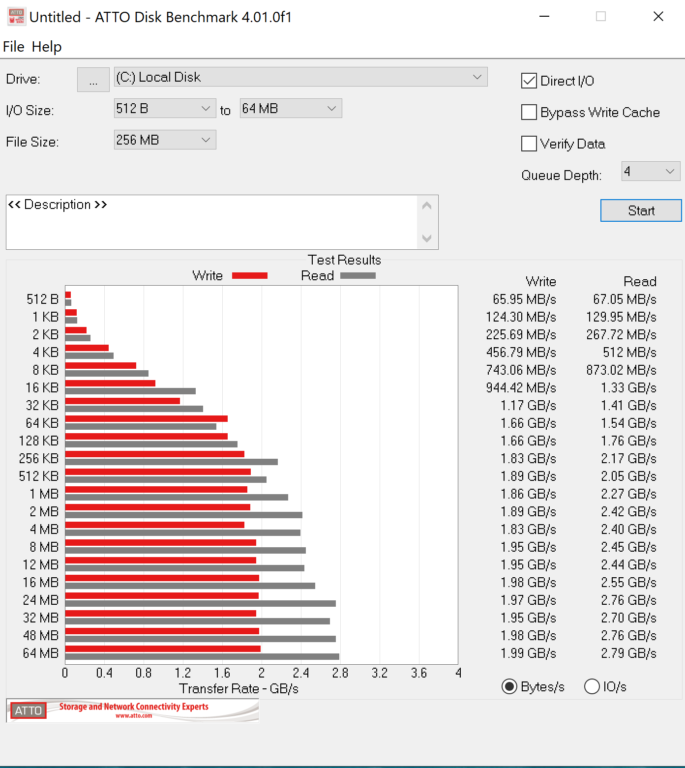INTEL H20 OPTANE MEMORY 1TB SSD BENCHMARKS
The following benchmarks were achieved with the H20 SSD and Intel Optane Memory status enabled. Each test was conducted three times and the top result published.
ATTO Disk Benchmark is perhaps one of the oldest benchmarks going and is definitely the main staple for manufacturer performance specifications. ATTO uses RAW or compressible data and, for our benchmarks, we use a set length of 256mb and test both the read and write performance of various transfer sizes ranging from 0.5 to 8192kb. Manufacturers prefer this method of testing as it deals with raw (compressible) data rather than random (includes incompressible data) which, although more realistic, results in lower performance results.
With performance highs just a bit below spec at 2.79GB/s read and 1.99GB/s write, we were actually impressed as, for the most part, performance demonstrated a steady increase commensurate with sample size.
CRYSTAL DISK BENCHMARK VER. 7.0.0 x64
Crystal Disk Benchmark is used to measure read and write performance through sampling of random data which is, for the most part, incompressible. Performance is virtually identical, regardless of data sample so we have included only that using random data samples.
THROUGHPUT
IOPS
Perhaps the most impressive result in our Crystal DiskMark benchmark is that Random 4K Q1T1 read result you see at the bottom left of the first chart. This speaks to the speed in which programs start and the system runs and is higher than we see in pretty much any SSD. The fact that read and write IOPS are double listed specifications is also noteworthy.
The toughest benchmark available for solid state drives is AS SSD as it relies solely on incompressible data samples when testing performance. For the most part, AS SSD tests can be considered the ‘worst case scenario’ in obtaining data transfer speeds and many enthusiasts like AS SSD for their needs.
Not the top results of the bunch but, once again, the read and write IOPS are fairly impressive as is the low 4K read score.
ANVIL STORAGE UTILITIES PROFESSIONAL
Anvil’s Storage Utilities (ASU) are the most complete test bed available for the solid state drive today. The benchmark displays test results for, not only throughput but also, IOPS and Disk Access Times. Not only does it have a preset SSD benchmark, but also, it has included such things as endurance testing and threaded I/O read, write and mixed tests, all of which are very simple to understand and use in our benchmark testing.
We have tested the Intel H20 Optane Memory 1TB SSD in both Full and Quick System Drive Benchmarks. The Full System Drive Benchmark uses real-world traces from popular applications and common tasks to test the performance of the fastest modern drives with a comprehensive set of tests spanning > 200GB of data.
The Quick System Drive Benchmark is a subset of the Full test and is more representative of typical daily usage to show what would be expected regarding hybrid SSD performance on a day-to-day basis.
We have not run a comparison on either as we feel the only fair test would have been to compare the H20 Optane against the H10 Optane. We did test the SSD with Optane disabled but it fared far lower than we see here, the reason of course being that the SSD is only running in two lanes… the result of which we will see in the next sections benchmarks.
 The SSD Review The Worlds Dedicated SSD Education and Review Resource |
The SSD Review The Worlds Dedicated SSD Education and Review Resource | 


An interesting scenario for engineer’s and production managers: Make an SSD that’s designed specifically for only laptop’s with extra large ram cache with roughly equal size dram (or have a desktop card with a 18650 holder { or caps? – with holder, customer who want can parallel more 18650 on demand} on board – like that gigabyte board).. Laptops have batteries, so loosing the data in the drive is not an issue if theres a battery. The OS can write frequently used data to ram cache primarily. The total drive cache will not be huge – perhaps 16, 32, 64gb to keep prices down. Put the duplication to dram in a queue for the firmware – when the drive is not being used, and then run it after the fact to keep read/write speeds to full dram speeds.